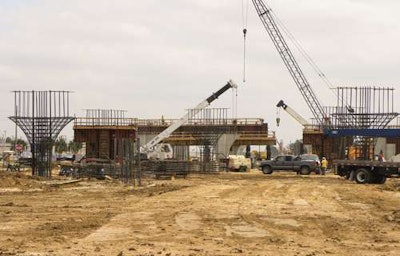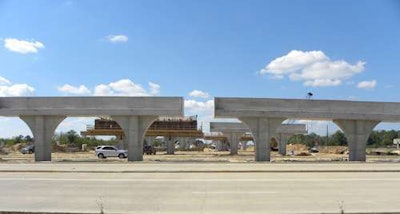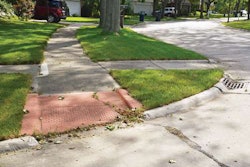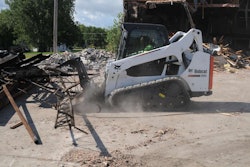
The six-lane highway (three in each direction) is used by thousands of Texans to commute to work and other destinations in the Houston metropolitan area. As the freeway heads north, it ends abruptly and commuters exit from the main lanes to a two-lane exit ramp to the frontage road with traffic signals.
This has resulted in traffic delays to the traveling public throughout the years. Also, the explosive growth in and around the city in recent years has increased the congestion, especially during rush hours.
With the Texas Department of Transportation (TxDOT) facing a shortage of funds, the Harris County Toll Road Authority (HCTRA) took a big step last year to solve this issue.
The agency decided to build three toll lanes in each direction along the existing SH 249 corridor and hired HCTRA hired Lockwood, Andrews & Newnam, Inc. (LAN), a planning, engineering and program management firm headquartered in Houston, to provide construction management services for a critical portion of the project.
The project includes 1.1 miles of six main lanes (three lanes in each direction), a 17-span bridge, two ramp toll plazas for entrance and exit ramps, and two detention ponds. Williams Brothers Construction Co., Inc. serves as the contractor.
Target milestones
With HCTRA funding the project primarily through revenue bonds, a critical goal is to complete the construction as early as possible so the agency can start generating toll revenue.
To achieve this goal, HCTRA has set the contractor two hard milestones, with disincentives for not completing the project on time.
The first milestone, MS-1, requires the completion of the two ramp toll plazas by Jan.15, 2015, from the time the project begins construction. The damages for not completing the ramp toll plazas on time are $2,500 per calendar day.
The second milestone, MS-2, requires the substantial completion of the main lanes and the bridge in 450 calendar days, with $15,000 damages per calendar day. There are no incentives to the contractor for early completion of the work.
“I have never worked on a project where the contractor is charged seven days a week, regardless of weather, holidays and weekends,” says Henry Quiroga, P.E., LANs resident engineer. “Usually, the contractor is charged five or six days a week that counts off of set milestones. In this project, every day counts from 450 to zero.”
Challenges and milestones
To achieve these milestones, the project team is proactively planning and executing different operations and navigating challenges as they emerge. One of the primary challenges is the concurrent construction of the Grand Parkway, a major four-lane project that runs east to west perpendicular to the Tomball project.
“The Tomball project goes under the Grand Parkway and over the frontage road,” says Quiroga. “It’s a three-tier level that requires complex coordination with several entities, including HCTRA, TxDOT, contractors and other engineering firms.”
For example, Quiroga says, when completing building the bridge substructure in the area of the Grand Parkway, coordination had to be done with Grand Parkway’s contractor to work during a specific time period and mobilized our crew and equipment accordingly.
 Completed columns and caps on this six-lane highway (three in each direction).
Completed columns and caps on this six-lane highway (three in each direction).“Now, they are building their bridge deck and are coordinating their activities with us,” Quiroga. “We meet several times on the field and plan tasks at least a month in advance to ensure that we don’t affect each other’s critical path.”
Another challenge the team encountered was the presence of numerous pipes in the detention pond.
“As we were digging the detention pond, we found 5,000 linear feet of old pipes that were not shown in the plans but had to be removed to excavate for the pond.” Quiroga says. “We had to procure an environmental contractor to come in and pull the pipes. To complicate matters, we were not able to procure the services of the environmental contractor that we first selected. So, we went to plan B and selected a different contractor. This whole process took longer than expected.”
The project team has also faced challenges such as rain delays and equipment problems.
Despite these challenges, the project is on course for completion in the summer of 2015.
Planning for the future
Unlike most projects, the Tomball Tollway is being constructed with minimal disruption to the traveling public. “Usually, when you extend an existing road, it affects traffic on a daily basis,” Quiroga says. “This project is unique in that the tollway is being constructed in the center away from the traveling public. As this project continues, commuters will continue using the frontage roads. It’s also good for the contractors as they don’t have to incorporate traffic controls.”
Additionally, anticipating future growth, HCTRA and the project team are constructing the Tollway with room on its bridge structures to add another main lane. This will save the agency money in the long run and prevent future widening projects that could be expensive and disruptive to the traveling public.
Upon completion, the project will significantly ease congestion in a critical region of Houston, reduce commuting times and give drivers a new option to use non-stop toll lanes in addition to the currently used non-tolled frontage roads. It also will enable faster connections to major locations such as the Bush-Intercontinental Airport, the Port of Houston and the Texas Medical Center, and potentially stimulate economic development along the corridor.
“This project comes at a crucial time for this community and is a win-win for all the stakeholders,” Quiroga says.
This article was contributed by Joel Schramm, regional transportation manager at Lockwood, Andrews & Newnam (LAN), a planning, engineering and program management firm headquartered in Houston.
Photos courtesy of Lockwood, Andrews & Newnam (LAN) and the Harris County Toll Road Authority.












